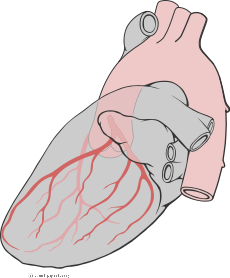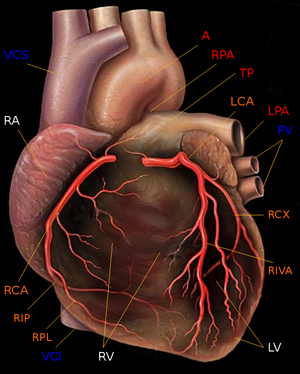- Arteriae coronariae
-
Als Koronar- oder Herzkranzgefäß wird eine Arterie bzw. Vene bezeichnet, die den Herzmuskel mit Blut versorgt oder dieses aus ihm abführt. Die Herzkranzgefäße sind kranzförmig um das Herz angeordnet. Das Wort stammt vom lateinischen coronarius, was kronen- oder kranzförmig bedeutet.
Inhaltsverzeichnis
Koronararterien
Die Koronararterien (Arteriae coronariae) gehen von der Aorta kurz nach der Aortenklappe ab. Es gibt eine linke (Arteria coronaria sinistra) und eine rechte Herzkranzarterie (Arteria coronaria dextra).
Die linke Koronararterie (LCA) teilt sich nach etwa 1 cm in den Ramus circumflexus (RCX) und den Ramus interventricularis anterior (RIVA, engl.: left anterior descending, LAD), welcher vorne zwischen linker und rechter Herzkammer zur Herzspitze zieht, auf. Bis zur Gabelung spricht man vom Hauptstamm (Truncus communis). Manchmal teilt sich der Hauptstamm auch in drei Gefäße auf, das mittlere wird dann als Ramus intermedius bezeichnet. Die linke Arterie versorgt die Herzvorderwand und die Seitenwand.
Die rechte Koronararterie (RCA) hat einen Hauptast, den Ramus interventricularis posterior (RIVP, engl.: posterior descendent artery, PDA). Die Hinterwand und der Sinus- und AV-Knoten werden im Regelfall von der rechten Koronararterie versorgt, ebenso die rechte Kammer und der rechte Vorhof und zum Teil auch linke Kammeranteile.
Beide Herzkranzarterien (Arteriae coronariae) geben in Ihrem Verlauf auch kleinere Äste ab, die jedoch je nach Versorgungstyp häufig Variationen unterliegen. Im folgenden sind die anatomischen Bezeichnungen aufgelistet, in Klammern sind die klinisch gebräuchlichen Bezeichnungen genannt, die relevanten, da meist kräftigen Gefäße sind kursiv.
Äste aus dem Ramus circumflexus (RCX):
- Ramus marginalis sinister (Ramus marginalis)
- Ramus atrialis
- Rami posteriores ventriculi sinistri
Äste aus dem Ramus interventricularis anterior (RIVA):
- Rami laterales (Ramus diagonalis)
- Rami interventriculares septales (Septaläste)
Äste aus der Arteria coronaria dextra (RCA):
- Ramus nodi sinuatrialis (Sinusknotenarterie)
- Ramus coni arteriosi
- Ramus atrialis
- Ramus marginalis dexter
- Rami atrioventriculares
- Aufteilung (Bifurkation) der RCA im Bereich der "Crux cordis" in
- Ramus interventricularis posterior (RIVP, anastomisiert häufig mit dem RIVA) mit seinen Rami interventriculares septales (bilden häufig Kollateralen zu den Septalästen des RIVA) und
- Ramus posterolateralis dexter
Versorgungstypen
Wenn die linke Herzkranzarterie auch die Hinterwand und die Knoten mitversorgt, spricht man von einem Linksversorgertyp, wohingegen man bei einer (Mit-)Versorgung der Vorderwand durch die rechte Koronararterie von einem Rechtsversorgertyp spricht; der Normalfall wird als Intermediärtyp bezeichnet.
Den Normalfall (bei rund 75 % der Bevölkerung) stellt der ausgeglichene Typ dar.
Die Arteria coronaria sinistra versorgt dabei:
- den linken Vorhof,
- die Muskulatur des linken Ventrikels,
- den Großteil des Septums interventriculare,
- einen Anteil der Vorderwand des rechten Ventrikels.
Die Arteria coronaria dextra versorgt:
- den rechten Vorhof,
- die Muskulatur des rechten Ventrikels,
- den hinteren Teil des Septum interventriculare,
- den Sinusknoten,
- den AV-Knoten,
- teilweise auch linke Kammeranteile.
Koronare Herzkrankheit
Die Koronararterien sind Terminalarterien, es gibt keine Umgehungskreisläufe, die im Notfall eine Versorgung übernehmen könnten. Im Falle eines Verschlusses stirbt das versorgte Gebiet ab (Myokardinfarkt, ischämische Nekrose). Sind die Herzkranzgefäße geschädigt, so spricht man von einer koronaren Herzkrankheit (KHK).
Koronarvenen
Die großen Koronarvenen (Venae cordis) laufen über weite Strecken parallel zu den Koronararterien und münden über den transversal laufenden Sinus coronarius im rechten Vorhof. Kleinere Koronarvenen münden direkt im rechten Vorhof oder in andere Herzräume, wie zum Beispiel die Vv. ventriculi dextri (rechter Ventrikel) und die Vv. cardiacae minimae bzw. Thebesiusvenen (Innenräume des Herzens).
Die großen Koronarvenen (Venae cordis) sind:
- Vena cordis magna
- Vena cordis media
- Vena cordis parva
Wikimedia Foundation.


